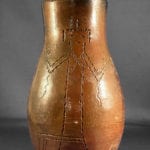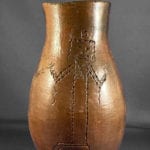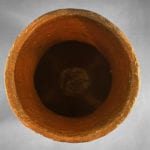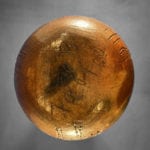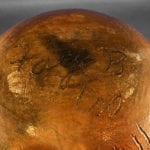Some history:
The Navajo migrated to what is now the southwestern USA from northwestern Canada and eastern Alaska about 100 years before Columbus “discovered” the Americas. As nomadic people, they did not have a pottery-making tradition. About 1700 CE a painted type of pottery (“Gobernador Polychrome”) may have been made by the Navajo along the San Juan River, but this tradition died out later in that century, perhaps because of religious prohibitions against painted pottery (Brugge, 1987:3-6). By 1750 almost all Navajo pottery was undecorated except for filets of clay (“biyo“) added around the neck of jars. (See pot 1969-07 in this collection.)
Shortly after their internment by the U.S. Army at Bosque Redondo (Fort Sumner) 1864 to 1868, railroads and thus Anglo traders reached Navajo country. In 1893 Alexander Steven wrote of the Navajo that “The older women still make cooking utensils of pottery, but the younger women no longer practice the art The iron camp kettles and tin cups and coffee pots brought in by the trader are rapidly displacing the primitive gourd ladles and earthen jars (quoted in Tschopik, 1941:47).” Based on his 1937-1938 research, Tschopik concluded that “(T)oday the craft (of pottery making) has become, for all intents and purposes, obsolete (1941:47).” “By 1950, the only part of the Navajo Reservation where pottery was being made in any quantity was the Shonto/Cow Springs region southwest of Kayenta (AZ) (Brugge, 1987:8)” and this was largely made by members of Reed People clan (Lok’aa’dine’e), almost exclusively for Navajo ceremonial use.
Before I discuss pot 2019-07, we need to hear again from Harry Tschopik, Jr:
“One of the most remarkable features of in connection with Najavo pottery is the number of ritual restrictions which accompany and surround every phase of its manufacture (1941:48.”
Between 3 informants, Tschopik reports 23 restrictions. Violating these prohibitions would prevent the sucessful forming or firing of a pot or bring direct physical harm to the potter, most frequently blindness (1941:48-50). In short, when Native American pottery began to become popular among collectors in the mid 1970’s, little Navajo pottery was being made and the process was constricted by multiple religious prohibitions.
The form of pot 2019-07:
The vase has substantial but not thick walls and a flat bottom for resting on a flat surfac. Its bulbous body narrows about 25% from the lip to form a slightly narrower neck. As is traditional with Navajo pottery, the surface has been covered with pinion sap that has been heated and strained to remove impurities. This the surface is shiny and somewhat waterproof.
Decoration:
The surface of the pot was smoothed with a tool that left slight striations, perhaps a dried corn cob. Three Yei figures are inscribed equidistant around the jar. Every creature, every aspect of creation, has its holy people and these spirits are ” Yei” (or Yeii). The form of the Yei on jar 2009-07 is similar to the depictions found on some Navajo pictorial rugs.
The head is a three-sided rectangle with an “F” shaped topknot, perhaps ceremonial feathers. The eyes and mouth are indicated by short incisions, though one Yei features eyes, a nose and a rectangular mouth.. Two Yei have earrings, one does not. Below the head for all three renditions is a long linear body that fans out at the bottom to form a dance kilt. An X-shaped bandolier crosses the chest. Arms are bent, four-fingered hands raised to shoulder height. From each elbow hangs a serpentine line, perhaps part of the costume. Around the waist is a dance sash. The lower edge of the dance kilt is embroidered with triangular elements. Two sets of parallel lines represent legs. Feet are not indicated.
If this Yei has a specific identity, I am unaware of it.
Faye B. Tso:
Faye first learned pottery making from “old, old Grandmother,” probably a relative of her husband (Rosenak, 1994:147). Then in the 1970’s, with the burgeoning interest in Native Southwest pottery by collectors, she studied again with Rose Williams. Rose Williams taught several generations of students the traditions of Navajo pottery making. Among her students were Faye Tso, Silas Claw and Louise Goodman. All of these potters are represented in this collection; see the Artist List. Of the many ritual restrictions on making pottery, perhaps the most central was the prohibition against depicting religious iconography. With pots like 2019-07, Faye violated this standard. She led a traditional life, speaking little English and was a herbalist. Yet her style of pottery is a radical departure from Navajo norms:
“Faye Tso is an unlikely revolutionary since (she lives a traditional life)…But Faye Tso is also one of the most innovative of the elder generation of Navajo potters….Emmett Tso, her medicineman husband… (says we) know how to properly treat the subject matter; we can depict Yei figures, etc. without bad ramifications…(Rosenak, 1994:147).”
Bruce McGee and his brother Ron are the sons of Cliff McGee who purchased the trading post at Keams Canyon on the Hopi reservation in 1938. Both sons are long time traders. Bruce remembers the day he first saw Faye’s pottery:
“Faye Tso came into the post one day in 1974 with several large pots appliquéd with corn and Yei figures. Before that, all we saw from the Navajo were dark, bulky, mud pots –good to drink from if you didn’t mind the flavor of the pitch. There was a worldwide market for Hopi pots at that time, but you couldn’t sell one that was Navajo made. With the discovery of Faye Tso, the Navajo became competitive (Rosenak, 1994:121).”
Faye’s innovations generated considerable controversy and resistance in her community. Eventually her use of Yei and other figures on her pots was tolerated because she was an important traditional medicine woman and herbal healer. Moreover, her husband and son, also healers, frequently used her pottery in their ceremonies. Thus her family position supporting traditional Navajo practice allowed to to innovate Navajo pottery.
With its Yei iconography, vase 20019-07 is a sacred pot. It is also an important marker in the evolution of Navajo pottery.


